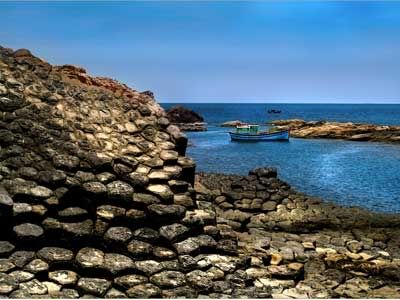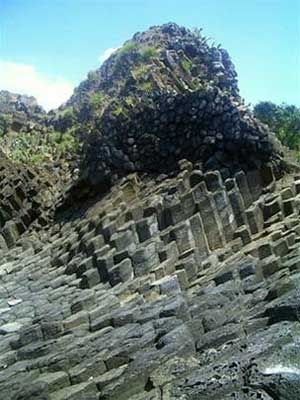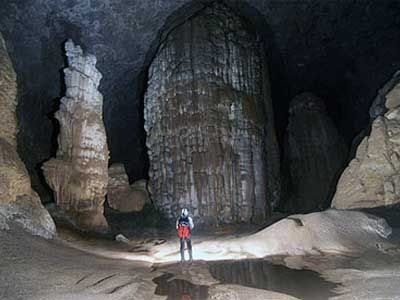
Located in An Ninh Dong Commune , Tuy An District, Phu Yen Province, Ghenh Da Dia is strangely structured rocks include large upright stones equally arranged in a star pattern. Being a riddle of nature, like a giant jigsaw, the rapids is irritatingly made of the same shaped pieces, and forms a solidified structure that has proved more than just a curiosity for thousands.
A strange geological phenomenon
Millions of years ago, during volcano eruption, mineral flows melting will be frozen when they encounter water and then the solid breaks into columns or obliques. That created the beautiful landscape of Ghenh Da Dia for the present time. Time over time, the landscape is rearranged as an artistic work by the hand of nature. Ghenh Da Dia is about 1km2 large, half in the sea and half above sea level.
Looking down on it, visitors often liken it to a gigantic beehive, others as a pile of stone plates. For despite a lengthy series of historical, archeological and scientific probes of the cliff’s square kilometer, its formation remains a mystery.
The stones in Ghenh Da Dia are bazan stones of dark black and light yellow. There exists large stones of tons and small stones with different shapes: round, pentagon, polygon and so on. The stones take the right column or a settlement close to each other like disks arranged on couples together. Even counting the stone columns has failed to yield an exact figure as exhausted researchers usually call a halt at around 35,000. The stones are 60-80cm in visible height and 20-30cm across and cluster round a small fresh water pond that is fed by underground rivers and never dries up.
And a wild beauty...
In Ghenh Da Dia, there only remains the unique scenery of the sea and stones, so everything is still primary, environment is so pure, air is fresh and comfortable.

Besides Ghenh Da Dia is Bang beach, with rocks “lie” quiet under the shadow of trees. This is quite ideal for relaxation, camping and extra activities. Ghenh Da Dia and the beach are closed with a famous tourist attraction which is "Hòn đá lực lượng" - a deep and wide grotto that saves the legendary people in a war period. In the war, our main force sheltered in the cave at night, waiting to the day to go on a sortie and dealt enemy thunderstruck blows.
Visiting Ghenh Da Dia, you have a chance to view many species of marine creatures, especially “Mứt” seaweed - a type of kelp which is salty and sticks to the stones, looking like a network.
Have been listed as a National Heritage Site by the Ministry of Culture and Information, Ghenh Da Dia is a potential tourist attraction to both domestic and foreign visitors. And a visit to the rapids, you will be certainly worth it...
Close to Hoi An town, Cu Lao Cham really cherishes high potential for tourism development.

